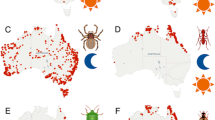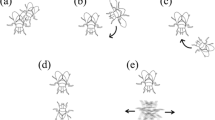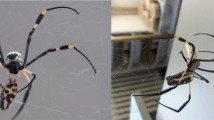Abstract
Interactions between prey and predators are often mediated by signals sent by the prey. Passive signals such as aposematic coloration and active signals such as pursuit deterrence signals are thought to prevent attack from predators. In true fruit flies (Diptera: Tephritidae), the defensive wing display is called supination, and studies have shown that supination effectively reduces the chance of being attacked by salticid predators. In this study, we investigated the proximal causes of supination in staged interactions in an arena. We asked whether the movement of the display target influences the likelihood of triggering supination in the Mexican fruit fly Anastrepha ludens. We tested the effect of motion on fly display in three different ways using (1) a manually moved dead spider or beetle, (2) live bouts with a spider and a katydid and (3) video playback experiments where movement of the display target was controlled. Our results show that flies are more likely to perform supination when the display target moves. The identity of the display target did not influence display propensity, suggesting that the supination of flies is a generalised display behaviour against any possible threat.


Similar content being viewed by others
References
Agresti A (2007) An introduction to categorical data analysis. Wiley, New Jersey
Bakeman R, Gottman JM (1986) Observing interaction. An introduction to sequential analysis. Cambridge University Press, Cambridge
Bakeman R, Robinson BF (1994) Understanding log-linear analysis with ILOG: An interactive approach. Erlbaum, Hillsdale
Benelli G (2013) Aggressive behavior and territoriality in the olive fruit fly, Bactrocera oleae (Rossi) (Diptera: Tephritidae): Role of residence and time of day. J Insect Behav 27:145–161
Benelli G (2015) Aggression in Tephritidae flies: where, when, why? Future directions for research in integrated pest management. Insects 6:38–53
Benelli G, Daane KM, Canale A, Niu C-Y, Messing RH, Vargas RI (2014) Sexual communication and related behaviours in Tephritidae: current knowledge and potential applications for integrated pest management. J Pest Sci 87:385–405
Blumstein DT, Daniel JC (2007) Quantifying behavior the JWatcher way. Sinauer Associates, Sunderland
Bond AB (2007) The evolution of color polymorphism: crypticity, searching images, and apostatic selection. Annu Rev Ecol Sys 38:489–514
Briceno R, Ramos D, Eberhard W (1999) Aggressive behavior in medflies (Ceratitis capitata) and its modification by mass rearing (Diptera: Tephritidae). J Kans Ent Soc 1:17–27
Caro T (1995) Pursuit-deterrence revisited. TREE 10:500–503
Crawley R (1993) GLIM for ecologists. Blackwell Scientific, Oxford
Edwards GB (2004) Revision of the jumping spiders of the genus Phidippus (Araneae: Salticidae). Occ Pap Fla Sta Coll Arth 11:1–118
Eisner T (1985) A fly that mimics jumping spiders. Psyche 92:103–104
Elias DO, Land BR, Mason AC, Hoy RR (2006) Measuring and quantifying dynamic visual signals in jumping spiders. J Comp Physiol A 192:785–797
Godin J, Davis S (1995) Who dares, benefits: predator approach behaviour in the Guppy (Poecilia reticulata) deters predator pursuit. Proc R Soc B 259:193–200
Greene E, Orsak L, Whitman D (1987) A tephritid fly mimics the territorial displays of its jumping spider predators. Science 236:310–312
Hasson O (1995) A fly in spider’s clothing: what size the spider? Proc R Soc B 261:223–226
Headrick DH, Goeden RD (1994) Reproductive behavior of California fruit flies and the classification and evolution of Tephritidae (Diptera) mating systems. Stud Dipterol 1:194–252
Hemmi JH, Pfeil A (2010) A multi-stage anti-predator response increases information on predation risk. J Exp Biol 213:1484–1489
Jackson RR (1977) Prey of the jumping spider Phidippus johnsoni (Araneae: Salticidae). J Arachnol 5:145–149
Mather MH, Roitberg BD (1987) A sheep in wolf’s clothing: tephritid flies mimic spider predators. Science 236:308–310
Murphy T (2006) Predator-elicited visual signal: why the turquoise-browed motmot wag-displays its racketed tail. Behav Ecol 17(4):547–553
Rao D, Díaz-Fleischer F (2012) Characterisation of predator-directed displays in tephritid flies. Ethology 118:1165–1172
Rundus A, Owings D, Joshi S, Chinn E, Giannini N (2007) Ground squirrels use an infrared signal to deter rattlesnake predation. PNAS 104:14372–14376
Ruxton G, Sherratt TN, Speed MP (2004) Avoiding attack: The evolutionary ecology of crypsis, warning signs and mimicry. Oxford University Press, New York
Sivinski J, Pereira R (2005) Do wing markings in fruit flies (Diptera: Tephritidae) have sexual significance? Fla Entomol 88:321–324
Tan K, Wang Z, Li H, Yang S, Hu Z et al (2012) An ‘I see you’ prey–predator signal between the Asian honeybee, Apis cerana, and the hornet, Vespa velutina. Anim Behav 83:879–882
Tejeda MT, Arredondo J, Pérez-Staples DF, Ramos-Morales P, Liedo P, Díaz-Fleischer F (2014) Effects of size, sex and teneral resources on the resistance to hydric stress in the tephritid fruit fly Anastrepha ludens. J Insect Physiol 70:73–80
Worthington AM, Swallow JG (2010) Gender differences in survival and antipredatory behavior in stalk-eyed flies. Behav Ecol 21:759–766
Zahavi A, Zahavi A (1997) The handicap principle. Oxford University Press, Oxford
Acknowledgments
We thank Diana Pérez-Staples, Ajay Narendra and anonymous reviewers for valuable comments on an earlier version of this manuscript. Thanks are due to Pablo Nuñez Berea for help in rearing the spiders and Dina Orozco (Subdirector of Production, MoscaFrut) for flies. We thank Quiyari Santiago for identifying the beetle. This project was funded by a Ciencia-Basica CONACyT grant (no. 168746) to D.R.
Author information
Authors and Affiliations
Corresponding author
Electronic supplementary material
Below is the link to the electronic supplementary material.
10164_2015_442_MOESM1_ESM.mov
Video demonstrating the defensive display of the tephritid fly Anastrepha ludens against a jumping spider Phidippus audax (MOV 2149 kb)
10164_2015_442_MOESM2_ESM.mov
Video demonstrating the display of the tephritid fly Anastrepha ludens against the katydid. Note the initiation of the display when the katydid moves (MOV 3257 kb)
About this article
Cite this article
Aguilar-Argüello, S., Díaz-Fleischer, F. & Rao, D. Motion-triggered defensive display in a tephritid fly. J Ethol 34, 31–37 (2016). https://doi.org/10.1007/s10164-015-0442-8
Received:
Accepted:
Published:
Issue Date:
DOI: https://doi.org/10.1007/s10164-015-0442-8




